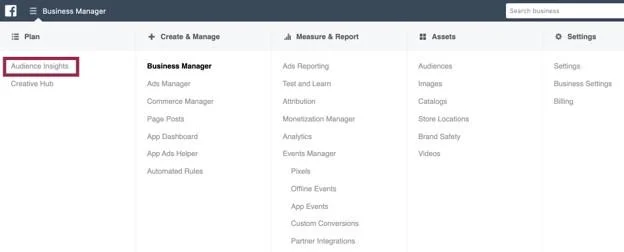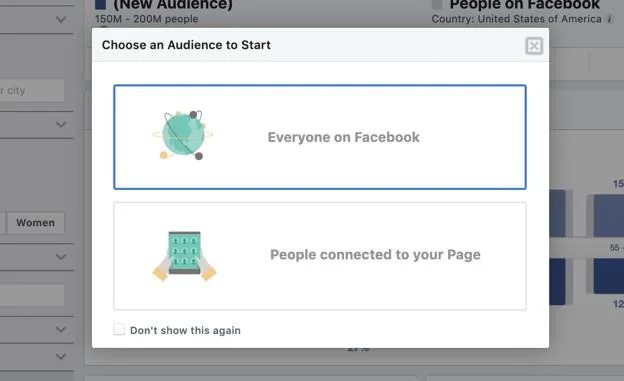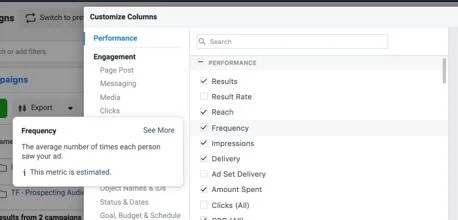It’s no secret that Facebook can be a fantastic place to reach new audiences and grow your business. We hear about crazy awesome success stories all the time: “I just put stuff on Facebook, and I don’t know what happened, but six months later I quit my job and my side hustle became my full-time gig!”
That’s all fine and dandy, but it’s definitely not the most common use case. I’ve heard more people, especially small businesses, have a completely different story: “We tried Facebook, but it just didn’t work for us.”
The first story is an uncommon case, and I actually believe the second one is, too.
There are quite a few ways Facebook can be leveraged for small businesses, but you have to set yourself up for success and have realistic goals given some of the limitations of the Facebook platform.
Here are my seven tips for how your small business can leverage Facebook ads and see success.
Get the PDF version of this post in your inbox >> 7 Fundamental Facebook Advertising Tips every advertiser should know.
1. Match campaign objectives to your goals
What is it that you’re trying to get out of Facebook ads? Additional sales, larger newsletter readership, increased awareness? This is a big factor in determining how your Facebook ads account will be set up. Luckily, Facebook ads has objectives outlined for nearly every goal you could have for your campaigns to choose from.
There’s not really a way for me to prescribe the right campaign objective for everyone.
If you’re interested in multiple, I encourage you to hover over each name and click the “i” icon next to each and read a little about their best use cases. Facebook provides a link for you to learn more about each as well, or you could read this post to get a rundown on each campaign type.
2. Find your target audience in Audience Insights
One of my favorite places to start with any new account is to understand the target audience. Facebook ads makes this very easy with its Audience Insights tool.
Note: You have to have your Facebook page tied to your Business Manager account to see this data. (We clear it all up in our Facebook ads tutorial.)
In the main navigation in Facebook Business Manager, head over to the planning section and choose “Audience Insights.”
You’ll then have a pop-up over the tool that asks if you want to start with all Facebook users (“Everyone on Facebook”) or only users who are connected to your business’s page (“People connected to your Page”). Once you choose “People connected to your Page,” it will highlight the area in the left-hand navigation where you can choose which Facebook page you want to see data for. Find your page, and you’re off to the races!
You’ll be able to see demographic info, activity on Facebook, device data, etc., all from this tool.
If the report comes back blank, then that means you likely don’t have a large enough audience for Facebook to provide insights. But don’t worry, that doesn’t mean all is lost.
More than likely, there are larger brands who are similar to yours that you can leverage. Let’s say you’re a modern furniture store. Similar brands might be West Elm and Crate and Barrel. You can type those brand names into the “Interests” section, just slightly above the Facebook page selector on the left side, and gain insights from their audiences instead.
All told, this data can be super helpful when you’re trying to decide what demographics to target, what interests people have, and potentially what devices you want to include.
In the end, you don’t have to only use this target audience, (hell, you don’t have to use it at all if you don’t want to), but it’s certainly a great place to start when it comes to understanding how your ideal customer translates to Facebook targeting.
If you’d like a further rundown on the Audience Insights Tool, check out this video for more.
3. Understand targeting layers
When setting up target audiences in Facebook ads, it’s important to understand the difference between AND and OR targeting logic. Knowing the difference here can be the difference between targeting 15,000 and 15,000,000.
There’s a pretty simple way to remember it by the way Facebook formats it: all targeting listed in a box is OR targeting while multiple boxes means AND targeting. Let’s jump into an example to illustrate.
In the image above, all targeted interests are considered OR targeting. This means that someone can be interested in Crate & Barrel OR AllModern to be included in our target audience. Each time you add another interest in this box, your target audience size will go up.
But let’s say you want to target people who like these brands, but only those who like this brand AND have a certain level of income. Here’s where the Narrow Audience function comes in.
When we narrow our audience, we’re effectively choosing the overlapping portion of the Venn diagram of the two groups as the image above shows.
So for our campaigns, we’ll choose to narrow the audience and layer in the income levels.
Our targeting section now looks like this with the two segments being in separate boxes. This shows that users have to fit any single criteria from the first box AND any single criteria from the second box to be included in our target audience. By adding the income segment in the second box, we’ve narrowed our target audience by quite a bit.
When you’re setting up your target audience and you have layers included like this, make sure you’re keeping the AND and OR targeting logic in mind and not being too narrow or too broad simply by not paying attention to the boxes.
4. Make sure your geotargeting is on point
There’s no prescribed target geography for a small business. Some SMBs are purely local and serve only their immediate community. Others are nationwide with wide appeal, and other might serve a very niche community worldwide.
No matter which category your business falls into, be sure you’re leveraging the proper geotargeting to reach your audience. All geotargeting settings for Facebook live at the ad set level.
The first thing to check is that you’re targeting people who are in a location with the right intent. This setting defaults to People living in or recently in this location, which is likely fine for most advertisers, but if you have more restrictions, you might want to adjust.
Let’s say you’re that local furniture store and you don’t ship outside of your immediate community. It might make sense to adjust to target only users living in this location, as you’ll be removing people who are either traveling in or were recently in that location. Either of these parties could easily be halfway across the globe by next week, and that would be a waste of your precious ad spend.
Once you’ve chosen that setting, the rest is fairly straightforward. Simply choose “Include” or “Exclude” from the dropdown, then start typing the location you want in the box to find the location you need. We’re able to target the following types of locations on Facebook:
- Countries
- States/Regions
- DMAs
- Congressional Districts
- Cities
- Postal/Zip Codes
- Addresses
Lastly, you can also choose the “Drop Pin” option in the lower right, and Facebook will give you a cursor to literally drop a pin wherever you like on the map. You’ll then be able to adjust the range around that pin to the mileage of your choice.
All told, the main goal with geotargeting is to be sure you’re not reaching users who are irrelevant to you because they’re too far away. Make sure you’re only focusing your ad spend in the areas that can reasonably drive potential business your way.
5. Keep retargeting and prospecting separated
This really goes for all businesses, not only SMBs, but I find that many SMB accounts often overlook the differences between retargeting and prospecting.
With retargeting, we’re reaching people who have already engaged with our brand in one way or another. These users could have visited your website, followed you on Facebook, or engaged with a post. They’re familiar with your brand to some extent already.
Prospecting is purely a game to extend reach and find new target customers. It’s the antithesis of retargeting.
When these audience types are combined into a single campaign, it can be harder to determine what is working best and who the more valuable audience is. Now that campaign budget optimization is in place, it’ll also be a bit harder to control the budget allocation between these groups.
I suggest keeping prospecting and retargeting in separate campaigns for easier management and optimization no matter what your objectives are.
6. Monitor your ad frequency
Frequency is the average number of impressions a user in any given audience has seen your ad in a given time frame (this time frame is dynamic based on the date range you’re viewing).
Whether you’re targeting a small, local community or a national niche, it’s important to make sure you’re not oversaturating your audience and bombarding them with your message.
This will be one of the easiest things to check in on as ad frequency is a column you can add to your campaign manager tab.
As a basic rule of thumb, your frequency should be half the number of days you have selected in your date range, e.g., if you have seven days selected, your frequency should be no more than three and a half days for any given audience.
7. Control your budgets effectively
The last Facebook advertising tip I want to give is solely about managing your spend in Facebook ads. This platform is unlike many others when it comes to budgeting. There are two key things to keep in mind:
Prepare for campaign budget optimization
Starting in February of 2020, all accounts will have all campaigns updated to campaign budget optimization, or CBO. This might not sound like a big deal, but it could be if your account isn’t set up for success.
In a nutshell, what CBO does is moves your budget management from the ad set level to the campaign level. Facebook then divvies up the budget based on which ad set is performing best.
The problem is that the ad set Facebook thinks is performing best isn’t always the same one you think is performing best. There have been many posts written about CBO and I encourage you to do your research on this topic as it will undoubtedly have an effect on your account.
Remember ad scheduling is tied to budgeting
In a previous post, I wrote about how lifetime and daily budgets impact your ad set/campaign settings and how you control when your ads show. Check out this article to learn more and be sure you’re getting the biggest bang for your buck when it comes to ad scheduling and budgeting.
Follow these Facebook advertising tips for small business marketers!
There’s no single, perfect strategy that works for Facebook ads, but small businesses should take extra consideration when diving into the platform to be sure you’re not overextending yourself too quickly. This is nearly always the source of the “I tried Facebook and it didn’t work” refrain. Here are the fundamental tips to follow to make sure you’re avoiding that:
- Match campaign objectives to your goals
- Find your target audience in Audience Insights
- Understand targeting layers
- Make sure your geotargeting is on point
- Keep retargeting and prospecting separated
- Monitor your ad frequency
- Control your budgets effectively
Hopefully, these tips will give you the confidence to test Facebook in a controlled way—and help make sure you’ll see returns for your efforts!
Want more? Check out The 8 Best (Free!) Facebook Ads Courses for Each Learning Level.
















0 Comments